

Are the world’s megacities too big? Are the world’s megacities becoming a sprawling, overfed, and uncontrollable mass that needs to be restrained for the good of society and the environment?
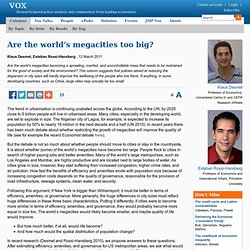
This column suggests that policies aimed at reducing the dispersion in city sizes will hardly improve the wellbeing of the people who live there. If anything, in some developing countries, such as China, large cities may actually be too small. The trend in urbanisation is continuing unabated across the globe. According to the UN, by 2025 close to 5 billion people will live in urbanised areas. Can the World Save Lives and Combat Climate Change? Environmental, humanitarian and economic challenges do not exist in isolation, but that is how the world most often deals with them.
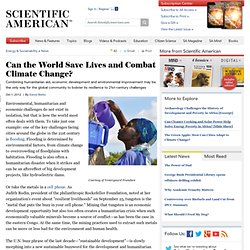
To take just one example: one of the key challenges facing cities around the globe in the 21st century is flooding. Flooding is determined by environmental factors, from climate change to overcrowding of floodplains with habitation. Flooding is also often a humanitarian disaster when it strikes and can be an aftereffect of big development projects, like hydroelectric dams.
Or take the metals in a cell phone. As Judith Rodin, president of the philanthropic Rockefeller Foundation, noted at her organization's event about "resilient livelihoods" on September 25, tungsten is the "metal that puts the buzz in your cell phone. " The U.N. buzz phrase of the last decade—"sustainable development"—is slowly morphing into a new sustainable buzzword for the development and humanitarian communities: resilience. Plus, "we are not winning the war on hunger. Life saver? Future Megacities. How the rise of the megacity is changing the way we live. Amid a clutter of 24-hour arc lights, gigantic cranes and dumper trucks, a behemoth is rising out of a field of churned mud on the outskirts of Chengdu in south-west China.
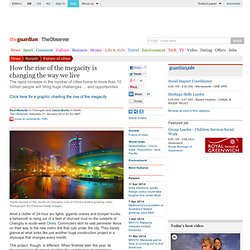
Commuters skirt its vast perimeter fence on their way to the new metro link that cuts under the city. They barely glance at what looks like just another huge construction project in a cityscape that changes every month. This project, though, is different. When finished later this year, its developers proudly boast, it will be the world's largest standalone building. The New Century Global Centre is a leisure complex that will house two 1,000-room five-star hotels, an ice rink, a luxury Imax cinema, vast shopping malls and a 20,000-capacity indoor swimming pool with 400 metres of "coastline" and a fake beach the size of 10 football pitches complete with its own seaside village.
Larger Cities Drive Growing Wage Gap Between the Rich and the Poor, Study Shows. February 7, 2011 In 1979 (the green line), wage inequality was roughly equal regardless of where workers resided.
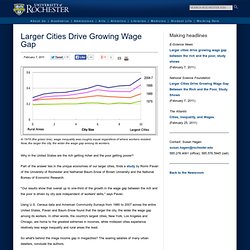
Looming disaster & Endless Opportunity. Mega City Challenges. Mega-cities reflect worst forms of inequality. Rio De Janeiro, Brazil: According to the United Nations Human Settlements Programme (UN-HABITAT), 40 urban “mega-regions” are home to 18% of the world's population.
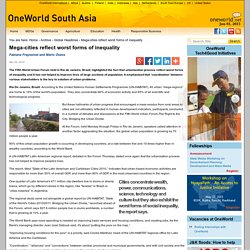
They also concentrate 66% of economic activity and 85% of all scientific and technological progress. But these hallmarks of urban progress that encouraged a mass exodus from rural areas to cities are not ultimately reflected in human development indicators, participants concluded in a number of debates and discussions at the Fifth World Urban Forum-The Right to the City: Bridging the Urban Divide. At the Forum, held Monday through Friday in Rio de Janeiro, speakers called attention to another factor aggravating the situation: the global urban population is growing by 70 million people a year. 90% of this urban population growth is occurring in developing countries, at a rate between five and 10 times higher than in wealthy countries, according to the World Bank.
Megacities. Get a taste of what awaits you in print from this compelling excerpt.

There once was a time when big cities thrilled and amazed people. Megacities - Boundless growth? Safe Shelter, Health and Wellbeing in Poorest Cities. This Human Rights Day, let's talk about housing.

We've been paying more attention to housing here in the U.S. lately, given the calamitous impact of Hurricane Sandy on entire New York and New Jersey communities and the countless American families with homes still in foreclosure. Globally, of course, the situation is even more dire. More than a billion people -- a sixth of the world's population -- live in slums; an additional 600 million inhabit substandard housing, another 100 million are homeless altogether, and every single week, more than a million are born or move into developing world cities. In-migration from failed harvests, climate change and the draw of urban opportunities has dramatically upped the pressure on these cities, where entire neighborhoods lack streets and drainage, clean water and sanitation, electricity, clinics and jobs, and yet the people keep coming.
Survival in megacities. More than 60% of humanity will be living in cities by 2030, according to a United Nations forecast.

Megacities – i.e. cities with more than 10 million inhabitants – are growing especially fast. The rise of megacities – interactive. UN report: World's biggest cities merging into 'mega-regions'